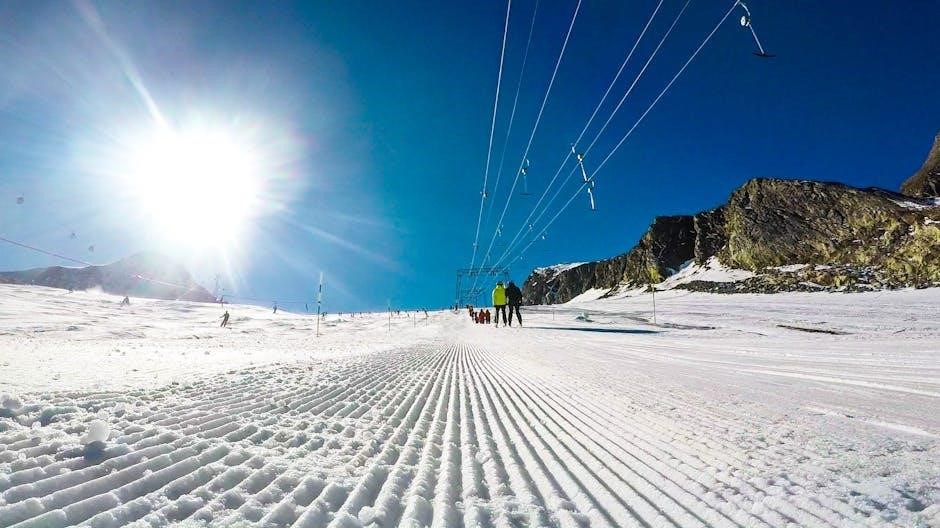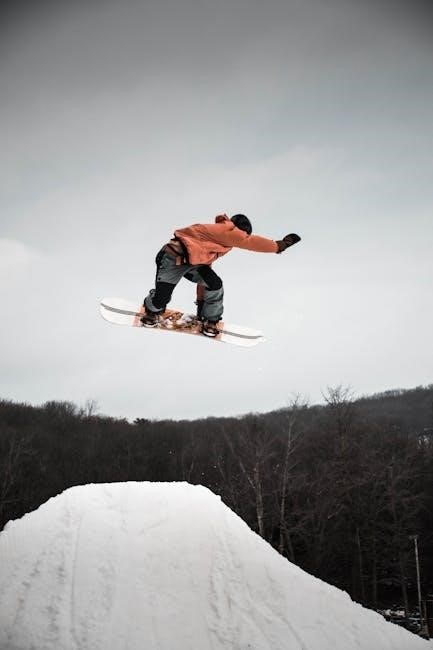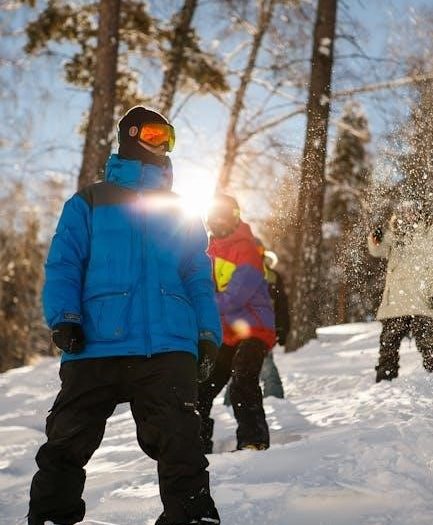Ski guides are essential components for loading and unloading snowmobiles safely․ They help align sleds, reduce strain, and improve trailer stability․ Properly installed ski guides ensure your snowmobiles stay securely on the trailer during transport, preventing shifting and damage․ They are designed to withstand the challenges of winter conditions while maintaining performance and durability․
The Importance of Trailer Ski Guides
Ski guides play a crucial role in ensuring safe and efficient snowmobile loading․ They provide alignment for sleds, preventing damage to both the snowmobiles and the trailer․ By reducing strain during the loading and unloading process, ski guides minimize the risk of accidents․ Proper alignment also ensures even weight distribution, enhancing trailer stability․ Additionally, durable materials like HDPE and vinyl allow ski guides to withstand harsh winter conditions while maintaining flexibility, protecting your equipment year-round․
Types of Trailer Ski Guides
Trailer ski guides come in various designs and materials to suit different needs․ HDPE (High-Density Polyethylene) guides are popular for their durability and resistance to cold weather․ Metal and plastic combinations offer strength and flexibility, while guides with slotted holes allow adjustment for seasonal expansion and contraction․ Some ski guides integrate with ramp doors, using vinyl lining like house siding for added flexibility․ Each type ensures snowmobiles load easily and stay secure during transport, catering to diverse trailer setups and user preferences․

Trailer Ski Guide Installation
Installation requires precise measurement to ensure proper fit and alignment․ Use screws and nuts to secure vertical supports, then attach ski guides to maintain flexibility․ Regular adjustments ensure stability during seasonal temperature changes, protecting your snowmobiles and trailer․
Preparing the Trailer for Guide Installation
Accurate measurement is crucial for proper installation․ Measure your trailer multiple times, including when loaded with a sled, to ensure precise positioning․ Use clamps or temporary fixings to test guide placement before drilling․ Proper alignment ensures stability and functionality․ Preparing the surface involves cleaning and ensuring it is level for secure installation․ Temperature variations may affect materials, so plan accordingly to avoid future issues․
Drilling and Securing the Ski Guides
Begin by aligning the ski guide in its intended position and marking the hole locations․ Use clamps to secure the guide temporarily, then drill pilot holes․ American Standard pilot hole sizes and drill bits are recommended to ensure a precise fit․ Secure the guide using galvanized screws and nuts, tightening them hand-tight to avoid overtightening․ Add washers to prevent grommets from loosening and ensure even pressure distribution․ Allow flexibility in the guide to accommodate seasonal temperature changes, similar to vinyl siding installation․ Double-check all connections for stability and resistance to movement or loosening over time․
Materials Used in Trailer Ski Guides
Trailer ski guides are made from high-density polyethylene (HDPE), offering durability and flexibility․ Metal and plastic combinations enhance strength and adaptability, ensuring long-lasting performance under various weather conditions․
HDPE (High-Density Polyethylene) Ski Guides
HDPE ski guides are renowned for their durability and flexibility․ Made from high-density polyethylene, these guides resist wear and tear while maintaining strength and weather resistance․ Their design allows for flexibility, preventing buckling during temperature changes․ HDPE ski guides are lightweight yet robust, ensuring long-lasting performance and reliability for trailer enthusiasts․
Metal and Plastic Combinations
Metal and plastic combinations in ski guide construction offer durability and flexibility․ Metal provides strength and rigidity, while plastic, often HDPE, adds resistance to wear and weather․ This blend ensures guides withstand harsh winter conditions without compromising on performance․ The metal framework supports structural integrity, while plastic components allow for flexibility, reducing stress during seasonal temperature changes․ Together, they enhance trailer stability and longevity, making them a versatile choice for enthusiasts․

Measuring for Trailer Ski Guides
Accurate measurement ensures proper ski guide placement․ Measure twice, use your snowmobile to verify placement, and ensure guides align with the trailer’s structure for even distribution and optimal fit, preventing misalignment and damage during transport․
Proper Measurement Techniques
Accurate measurement is crucial for effective ski guide installation․ Measure the trailer deck carefully, ensuring alignment with thecrossbars and structural supports․ Use elongated or slotted holes to account for seasonal temperature changes, allowing flexibility while maintaining durability․ Always measure twice, load your snowmobile into the trailer, and verify placement to ensure guides fit properly and reduce wear and tear․
Aligning Ski Guides on the Trailer
Aligning ski guides ensures smooth snowmobile loading and unloading․ Begin by checking the trailer’s structural supports to ensure guides are evenly spaced and parallel․ Securely install vertical supports at the front and rear, using four screws and nuts, and hand tighten for stability․ Align ski stopper blocks with the bushings holes on the ski assembly to maintain proper positioning․ Leave elongated or slotted holes for flexibility, accommodating seasonal temperature changes․ Double-check alignment and fit before final installation, and consider using vinyl lining for a polished, professional finish․

Trailer Support Structures
Trailer support structures ensure durability and stability․ Front and rear supports are installed using screws and nuts, securing ski guides firmly․ Proper alignment with ski assemblies ensures safety and smooth operation․ Vertical supports distribute weight evenly․ Seasonal temperature changes require flexible materials to maintain strength and performance․
Vertical Supports for Ski Guides
Vertical supports are critical for securing ski guides to the trailer․ They provide stability and ensure proper alignment during snowmobile loading․ Install them at the front and rear of the trailer using screws and nuts to maintain immobility․ These supports help distribute weight evenly, preventing damage to the trailer’s structure․ Proper alignment with the ski assemblies ensures a smooth and safe interaction between the sled and the guides, enhancing overall performance․
Arranging Supports for Stability
Properly arranging vertical supports is vital for ensuring the stability of ski guides on your trailer․ Measure and mark the placement carefully, drilling pilot holes to avoid splitting the trailer’s frame; Space the supports evenly to distribute weight evenly and prevent uneven wear․ Use bolts and nuts to secure them tightly, ensuring they remain immobile․ Placing supports near the front and rear of the trailer enhances alignment and stability during loading and transport․ This setup ensures your ski guides function smoothly, minimizing stress on the trailer’s structure․ Always double-check measurements to protect your equipment and maintain long-term durability․

Ski Guide Placement on Ramp Doors
Installing ski guides on ramp doors ensures smooth snowmobile loading and unloading․ Use vinyl lining to enhance flexibility and prevent damage to the trailer․ Measure and align the guides accurately to maintain proper snowmobile alignment while entering or exiting the trailer․ This setup improves efficiency and safety during snowy conditions․
Installing Ski Guides on Trailer Doors
Installing ski guides on trailer doors is crucial for smooth snowmobile loading and unloading․ Begin by measuring the doors accurately and marking the positions for the guides․ Use bolts or screws to secure the guides, ensuring they align perfectly with the trailer’s structure․ For flexibility, install the guides with grommets or bushings, allowing them to move slightly with temperature changes․ Reinforce attachments for durability, especially in snowy conditions․ Vinyl lining can be used to enhance flexibility and prevent damage to the trailer doors․ Always test the alignment by loading a snowmobile to ensure proper fit and adjust as needed․ Regular seasonal inspections help maintain functionality and prevent wear․
Using Vinyl Lining for Ski Guide Flexibility
Vinyl lining offers exceptional flexibility and durability for trailer ski guides, especially in cold weather․ This lining prevents buckling by allowing the guides to expand and contract with seasonal temperature changes․ Install vinyl by applying it to the trailer doors, much like house siding, to enhance longevity․ It creates a smooth surface for snowmobile skis, guiding them safely during loading and unloading․ Using vinyl ensures your trailer remains secure and functional, reducing wear and tear while maintaining performance in harsh winter conditions․ This flexible material is a practical choice forlong-term trailer safety and reliability․

Maintenance of Trailer Ski Guides
Regular cleaning and inspection ensure trailer ski guides remain functional․ Remove debris and check for wear or damage․ If guides are worn or broken, replace them promptly to maintain proper Alignment and performance․ Regular upkeep extends the life of the guides and ensures safe snowmobile transport․
Cleaning and Inspection
Regularly inspect your trailer ski guides for wear, cracks, or misalignment․ Clean debris and snow to maintain sliding performance․ Check for any damage to the HDPE material, especially along the edges․ Ensure the guides are properly aligned with your snowmobile skis for smooth loading․ Inspect the mounting hardware for tightness to prevent loosening during transport․ Remove dirt buildup to preserve durability and prevent corrosion․ A thorough inspection ensures your guides remain functional and safe for use in varying weather conditions․
Replacing Worn-Out Ski Guides
Replace your trailer ski guides promptly if they show signs of wear, cracks, or deformation․ Measure the existing guides carefully to ensure the new ones fit properly․ Choose high-quality HDPE ski guides for durability and flexibility․ Before installation, inspect the trailer’s ramp doors or deck for alignment․ Use a marker to outline the guide positions and drill new holes if necessary․ Ensure the new guides are securely fastened with screws and grommets to allow slight movement․ Proper replacement ensures your trailer remains safe and functional for years to come․

Modifying Trailer Ski Guides
Modifying ski guides improves functionality and adapts to specific snowmobile sizes․ Adjusting positions ensures better alignment during loading, preventing damage․ Upgrading designs enhances durability and flexibility, accommodating seasonal temperature changes․ Proper modifications maintain trailer performance and safety for years․
Adjusting Ski Guide Positions
Adjusting ski guide positions ensures optimal alignment for safe snowmobile loading and unloading․ Measure twice to confirm placement accuracy, as improper spacing may cause damage or misalignment․ Test placement by loading sleds to verify alignment and adjust guides as needed․ Elongated or slotted holes in ski guides allow flexibility for seasonal temperature changes, preventing buckling․ Proper adjustments improve stability and durability, making the process smoother and safer for your snowmobiles․

Upgrading to Improved Ski Guide Designs
Upgrading ski guide designs enhances functionality and longevity․ High-density polyethylene (HDPE) is widely used due to its durability and weather resistance․ Improved designs often incorporate elongated holes, allowing guides to flex with seasonal temperature changes․ Advanced designs may include reinforced materials or polymer blends for superior durability․ These upgrades maintain proper alignment while adapting to varying trailer sizes and weights, ensuring optimal performance in demanding conditions․ Innovations like these modernize trailer ski systems for safer, more reliable snowmobile transport․

Comparing Trailer Ski Guides to Other Snowmobile Trailer Accessories
Trailer ski guides, traction bars, deck liners, and ramp doors each serve unique roles in snowmobile transportation․ Ski guides ensure proper alignment and prevent shifting, while traction bars enhance grip during loading․ Deck liners protect the trailer and snowmobile from damage, and ramp doors assist in guiding snowmobiles up the ramp․ Despite their differences, each accessory contributes to a safer and more efficient trailer setup, with ski guides being essential for alignment and stability․
Ski Guides vs․ Traction Bars
Ski guides are designed to align snowmobiles during loading, ensuring proper placement and preventing shifting․ In contrast, traction bars enhance grip and stability on ramp doors, relying on friction to secure sleds in place․ Ski guides often use flexible materials like HDPE, while traction bars are typically made of more rigid materials for grip․ Both accessories are crucial for safe snowmobile transport, offering complementary benefits to ensure alignment, traction, and overall trailer efficiency․
Ski Guides vs․ Deck Liners
Ski guides are essential for aligning snowmobiles during loading, ensuring proper placement and preventing shifting․ In contrast, deck liners provide cushioning and protect the trailer deck from damage․ Ski guides often use flexible materials like HDPE to accommodate seasonal expansion, while deck liners are typically made of vinyl or other protective materials for durability․ Both accessories serve different purposes but are vital for trailer performance and snowmobile safety․ Proper installation of both ensures a smooth loading process and protects equipment from wear and tear․

Best Practices for Using Trailer Ski Guides
Measure twice to ensure proper alignment of sleds․ Always align the snowmobiles straight to avoid tipping․ Ensure guides are secured to prevent shifting during transit․ Regularly inspect and clean to maintain functionality․ Adjust guides if needed for optimum performance and safety․
Loading Snowmobiles Safely
Loading snowmobiles safely requires precise alignment and secure placement with ski guides․ Measure the trailer deck carefully, ensuring the sleds fit straight and centered․ If slight adjustments are needed, use the ski guides to gently muscle the sleds into position․ Avoid tilting orOverloading to prevent tipping․ Secure the sleds tightly to maintain stability during transport․ Proper alignment with ski guides ensures a smooth loading process and a safe journey․
Ensuring Proper Alignment and Fit
Ensuring proper alignment and fit with trailer ski guides is crucial for snowmobiles․ Measure the trailer deck carefully to determine the optimal position for the ski guides․ Align the sleds straight and centered, using the guides to adjust if necessary․ Avoid tilting or overloading, as this can cause instability․ Proper alignment ensures the sleds remain secure during transport, reducing the risk of shifting or damage․ Always confirm the fit before securing the sleds tightly to maintain stability and prevent potential accidents․
Trailer ski guides ensure safe snowmobile transport․ Proper installation, alignment, and annual maintenance protect your equipment․ HDPE and metal combinations provide durability in harsh winter conditions․ Follow these tips to maintain optimal performance and longevity of your trailer setup․
Trailer ski guides are vital for safe snowmobile transportation․ They ensure proper alignment, reduce strain on equipment, and enhance stability․ Proper installation involves accurate measurements and alignment․ HDPE and metal-plastic combinations provide durability․ Regular cleaning and inspection maintain performance․ Upgrading designs can improve functionality․ Always follow best practices for a secure and efficient trailer setup․
Final Tips for Maintaining Trailer Performance
To ensure optimal performance of your trailer ski guides, regularly inspect and clean them to prevent wear and tear․ Check for alignment issues and tighten any loose connections․ Use high-quality materials like HDPE for long-lasting durability․ If ski guides show signs of wear, replace them promptly to avoid damage to your snowmobile during transport․ Always measure your trailer accurately before installation to ensure proper fit, and consider upgrading to improved designs for better functionality․ By maintaining these practices, you can extend the life and efficiency of your trailer ski guides․
